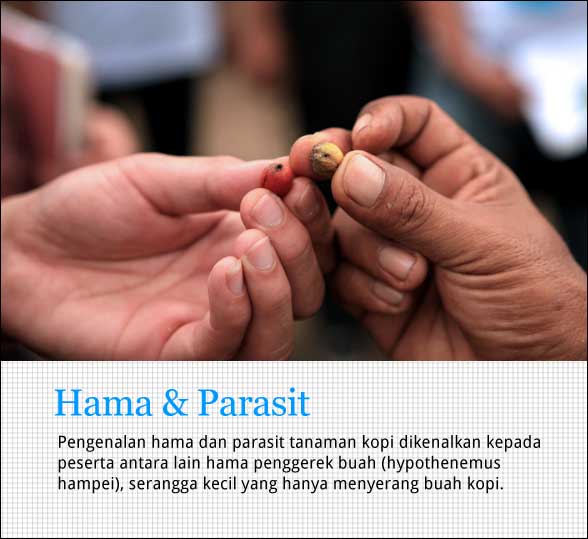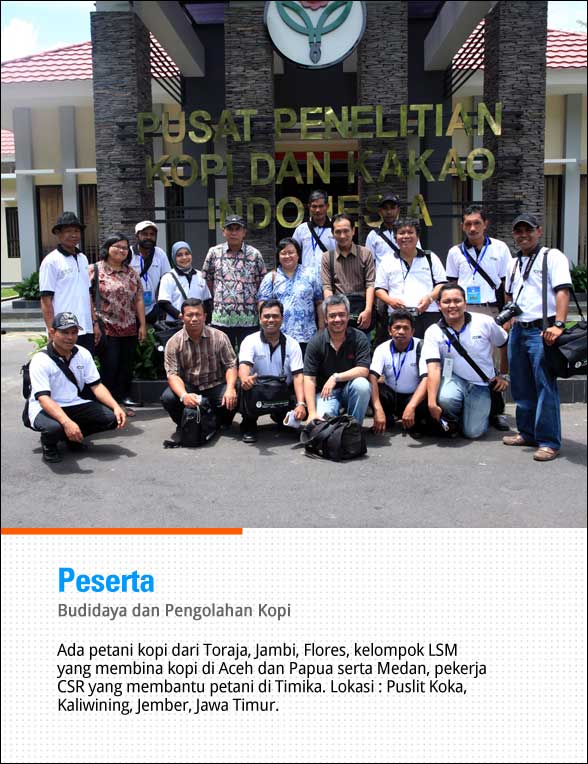Image 1: Coffee Cultivating Class. Attended by 18 participants consisted of farmers, mentors and representatives from various non-governmental organizations in Aceh, Toraja, Jambi, Medan and even Papua.
“There’s an old Javanese saying that says, when choosing a life partner, there are three things that one should look at; their bibit, bebet, and bobot (origin, family and personality). And it’s the same when it comes to planting coffee.” Explained Dwi Nugroho (32), as the first lecturer who began the Coffee Cultivating and Processing training. Attended by dozens of participants from all over Indonesia and also Specialty Coffee Association of Indonesia (SCAI), it was held from January 31st to February 4th 2012, at the Indonesian Coffee and Cocoa Research Institute (ICCRI) at Jember, East Java.
Image 2: Pests and parasites in coffee plantation. Participants got to see what they look like, including hypothenemus hampei, a fruit borer pest that preys solely on coffee crops.
I won’t bore you with the detailed materials from the training, but since the first day I attended the class and listened to the experts talking about coffee crops and its sub disciplines, one thing I am sure of is this; growing coffee is not an easy profession. According to Dwi, since the day you choose your seedling seed, farmers and especially their mentors must be able to differentiate all kinds of seeds. The genetical information and the origin carried by the seed must be traceable. Metaphorically speaking, “It must be clear who their parents (legitimate and propeligitimate) are, so multiplication and cloning system are possible to implement. I suggest avoiding seeds which origins are unclear (random seeds) so your coffee crop retains a clear ‘clan’ to maintain its quality and production consistency.” Said Dwi.
Once you have clarified a seed’s origin and quality, the next step is multiplying it, and that was the next lesson presented by Pudji Rahardjo. He explained about the seedlings that have been produced by ICCRI since the 90s as well as their varieties, including their pests and parasites prevalence. In truth, creating a new seedling takes a lot time, around 10 – 15 years until it is nationally certifiable. A lot of research and lab experiments must be done before the seedling can be released to be planted by the coffee farmers.
Image 3: Sri Sukamto Sugiarto, one of the researchers at Indonesian Coffee and Cocoa Research Institute who specializes in crop protection.
Recognizing coffee pests and parasites must be done thoroughly so an endemic prevention and handling can be localized early, especially at the nursery stage. Farmers and mentors must do a thorough and precise diagnosis so endemic controls can be directly executed. It is inadvisable to use the aid of a random pesticides since it will kill healthy crop as well as create an imbalance environment. Those are just some of the things I learnt from Recognizing and Controlling Coffee Plant Disease, which was presented by Sri Sukamto Sugiarto, an expert in crop protection.
“Is it possible to neuter a male insect that usually stays inside the coffee bean in our crops so it can no longer inseminate the female insects?” it was one of the questions I asked when the lecturer explained about the kinds of pests that exist in coffee crops. Indeed, it is possible, but yet it is not an easy task to bring all the male insects together and neuter them so these hematodes can no longer multiply. Coffee crop pests was a very interesting subject which was taught by Sri Sukamto Sugiarto, a graduate from Gadjah Mada university who specialized in Fitophatology, a study of plants and its diseases (are caused by fungus, bacteria, virus, nematodes, endemic) and how to control them.
Image 4: The Participants for the Cultivating and Processing Coffee class. Coffee farmers from all over Indonesia such as Toraja, Jambi, Flores and representatives from non-governmental organizations that focus on coffee processing in Aceh, Papua and Medan, as well as Corporate Social Responsibility (CSR) workers who help the farmers at Timika. Location: Indonesian Coffee and Cocoa Research Institute, Kaliwining, Jember, East Java.
Another subject that was just as intriguing was the Introduction to Coffee Machines and Equipment, which was brought by Edy Suharyanto, who talked about many coffee processing equipments and their aptitudes that are produced at ICCRI in a range of prices. Interesting cases always come up every now and then, like utilizing a rack to dry coffee beans that have been washed, to prevent them from getting contaminated by dirt, as what usually happens to previously washed coffee beans that are dried on large mattings spread out a large concrete or a patio. According to Yustarmizi Candra – one of the reps from Aceh, some farmers still prefer the second drying method, because it doesn’t affect the prices offered to the customers despite knowing that the coffee they bought is dried in this method. Edy reminded that technology still had its limitations, but one of the technological missions in farming was to make the farmers’ jobs easier as well as improving the products’ quality and quantity.
Other than practising on processing coffee, the participants were invited to observe their trial farm at Andungsari, in Bondowoso regency, which took less than 1.5 hour to reach from Jember. This event also ended the Cultivating and Processing Coffee training that was facilitized by SCAI and ICCRI in Jember.
* * * *
Budidaya & Pengolahan Kopi (2/2)
“Bila memilihi jodoh, sebagaimana pepatah Jawa, perhatikan bobot, bibit, dan bebet, demikian pula halnya dengan tanaman kopi” ujar Dwi Nugroho, SP (32) sebagai pembicara pertama yang membuka pelatihan Budidaya dan Pengolahan Kopi. Dihadiri oleh belasan peserta yang didatangkan dari berbagai daerah di Indonesia oleh Asosiasi Kopi Spesial Indonesia (AKSI) yang berlangsung dari tanggal 31 Januari hingga 4 Februari di Pusat Penelitian Kopi dan Kakao (Puslit Koka), Jember, Jawa Timur.
Tentunya saya tidak akan menulis semua materi pelatihan, tapi sejak awal duduk di kelas dan mendengar pemaparan para ahli dibidang pertanian kopi dari berbagai sub disiplin keilmuan, bisa disimpulkan bahwa betapa tak mudah menjalani profesi ini. Sejak pemilihan bibit unggulan, menurut Dwi, petani dan khususnya penyuluh harus bisa membedakan berbagai jenis benih. Informasi genetika yang dikandung benih sebaiknya bisa ditelusuri asal usulnya atau dengan kata lain jelas siapa “kedua atau salah satu orang tuanya” (legitim dan propeligitim) hingga bisa dilakukan perbanyakan dengan sistem klonal misalnya. Sebaiknya dihindari bibit yang tidak jelas asal usulnya (benih sapuan) agar tanaman kopi tetap mempunyai “marga” yang jelas untuk menjaga kualitas dan konsistensi hasil produksi.
Jika bibit sudah jelas asl usul dan kualitasnya, proses selanjutnya adalah perbanyakan benih tanaman kopi yang disajikan Oleh Ir. Pudji Rahardjo, SU. Berbagai bibit unggulan yang telah dihasilkan oleh Puslit sejak tahun 90an hingga sekarang dijelaskan oleh Pudji beserta keunggulan yang dimiliki oleh masing-masing varietas termasuk prevalensi hama dan parasitnya. Ternyata menghasilkan sebuah bibit baru memerlukan jalan yang sangat panjang, sekitar 10 hingga 15 tahun untuk bisa mendapatkan sertifikasi nasional. Berbagai penelitian dan percobaan di laboratorium harus dilakukan sebelum sebuah bibit bisa dilepas untuk ditanam oleh para petani kopi.
Bisakah kita memandulkan serangga jantan yang biasanya ngendon di dalam biji kopi sehingga mereka tidak bisa lagi memperbanyak dirinya? Itu salah satu pertanyaan yang saya ajukan saat salah seorang pengajar menjelaskan tentang berbagai hama pada tanaman kopi. Tentu saja bisa dilakukan, tapi bukan hal yang mudah untuk mengumpulkan para jantan lalu dilakukan “vasektomi” agar mereka hewan nematoda ini tidak bisa lagi beranak pinak. Hama tanaman kopi adalah subjek yang sangat menarik yang dibawakan oleh Ir. Sri Sukamto Sugiarto, lulusan S2 Universitas Gajah Mada dengan spesialisasi Fitopatologi yang meneliti penyebab penyakit tanaman yang bisa diakibatkan oleh cendawan, bakteri, virus, nematoda, endemik serta pengendalian penyakit tanaman.
Materi lain yang tak kalah menarik adalah Pengenalan Alat dan Mesin Kopi yang disajikan oleh Edy Suharyanto, STP, MP. Berbagai alat pengolahan kopi beserta beserta berbagai aspek keunggulan yang sebagian sudah diproduksi di Puslit Koka dengan berbagai variasi harga. Selalu ada kasus menarik, misalnya penggunaan para-para untuk mengeringkan kopi agar tidak terkontaminasi kotoran dibandingkan dijemur di atas tanah atau lantai semen. Sebagian petani masih melakukan penjemuran di atas lantai karena menurut Yustarmizi Candra, salah satu penyuluh dari Aceh tidak ada perbedaan signifikan dari segi harga dari pembeli walau alat yang relatif murah ini digunakan. Menurut Edy, beberapa teknologi memang tidak selalu bisa diaplikasikan, tapi salah satu misi teknologi bidang pertanian adalah untuk memberikan kemudahan bagi para petani sekaligus meningkatkan kualitas dan kuantitas produksi.
Selain praktek pengolahan kopi, para peserta diajak untuk meninjau kebun percobaan Andungsari di Kabupaten Bondowoso yang ditempuh selama lebih kuran 1.5 jam dari Jember. Acara ini sekaligus menutup Budidaya dan Pengolahan Kopi yang difasilitasi oleh AKSI bersama Puslit Koka di Jember.
* * * * *





 Brewing coffee is truly a combination of art and science. It takes knowledge, skills, and most importantly, passion for a perfection. The contents of this coffeelicious blog is created by me, who effortlessly cool and adorable by nature. Trusting me at your own risks.
Brewing coffee is truly a combination of art and science. It takes knowledge, skills, and most importantly, passion for a perfection. The contents of this coffeelicious blog is created by me, who effortlessly cool and adorable by nature. Trusting me at your own risks.
eh,..ada pak Salladin di fotonya.. aheeiinggggg….
gua jadi kagak ngantuk neeh bung tonny..!! jadi kapan mau beli kebun di tanah gayo?